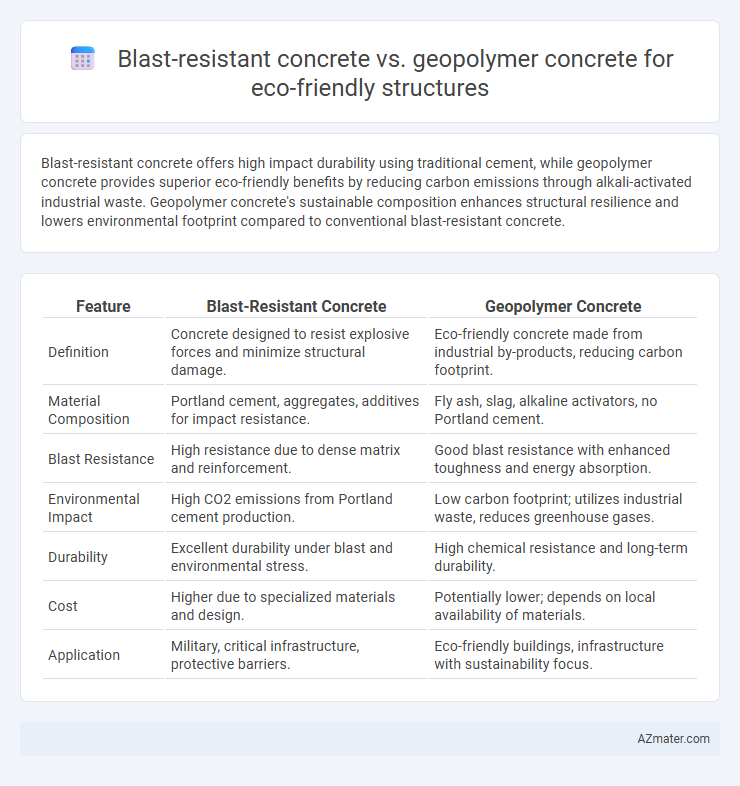Blast-resistant concrete offers high impact durability using traditional cement, while geopolymer concrete provides superior eco-friendly benefits by reducing carbon emissions through alkali-activated industrial waste. Geopolymer concrete's sustainable composition enhances structural resilience and lowers environmental footprint compared to conventional blast-resistant concrete.
Table of Comparison
| Feature | Blast-Resistant Concrete | Geopolymer Concrete |
|---|---|---|
| Definition | Concrete designed to resist explosive forces and minimize structural damage. | Eco-friendly concrete made from industrial by-products, reducing carbon footprint. |
| Material Composition | Portland cement, aggregates, additives for impact resistance. | Fly ash, slag, alkaline activators, no Portland cement. |
| Blast Resistance | High resistance due to dense matrix and reinforcement. | Good blast resistance with enhanced toughness and energy absorption. |
| Environmental Impact | High CO2 emissions from Portland cement production. | Low carbon footprint; utilizes industrial waste, reduces greenhouse gases. |
| Durability | Excellent durability under blast and environmental stress. | High chemical resistance and long-term durability. |
| Cost | Higher due to specialized materials and design. | Potentially lower; depends on local availability of materials. |
| Application | Military, critical infrastructure, protective barriers. | Eco-friendly buildings, infrastructure with sustainability focus. |
Introduction to Eco-Friendly Structural Materials
Eco-friendly structural materials such as blast-resistant concrete and geopolymer concrete offer sustainable solutions by reducing environmental impact and enhancing durability. Blast-resistant concrete utilizes high-strength aggregates and advanced admixtures to improve structural safety against explosive forces while maintaining eco-conscious production methods. Geopolymer concrete, made from industrial by-products like fly ash and slag, exhibits low carbon emissions and superior chemical resistance, making it a prime candidate for green construction.
Understanding Blast-Resistant Concrete
Blast-resistant concrete is engineered with enhanced density and compressive strength to withstand high-impact forces from explosions, making it essential in protective and security-sensitive structures. Its composition often includes steel fibers, polypropylene fibers, and specialized aggregates that improve energy absorption and reduce spalling during blasts. Understanding the material's response to shock waves and optimizing its microstructure are critical for designing eco-friendly buildings that balance durability with sustainability by minimizing material use and extending lifespan.
Overview of Geopolymer Concrete
Geopolymer concrete is an innovative eco-friendly building material that uses industrial byproducts such as fly ash and slag, significantly reducing carbon emissions compared to traditional Portland cement. Its superior fire and blast resistance make it ideal for structures requiring enhanced durability and safety. The material's low embodied energy and excellent mechanical properties contribute to sustainable construction with reduced environmental impact.
Environmental Impact Comparison
Blast-resistant concrete often relies on traditional Portland cement, contributing significantly to CO2 emissions and environmental degradation during production. Geopolymer concrete utilizes industrial by-products like fly ash or slag, drastically reducing carbon footprint and energy consumption while offering comparable blast-resistant properties. The environmental impact comparison highlights geopolymer concrete as a more sustainable choice for eco-friendly structure development due to its lower greenhouse gas emissions and resource efficiency.
Material Composition and Sustainability
Blast-resistant concrete typically incorporates high-strength cement, aggregates, and additives like steel fibers or polymers to enhance energy absorption and durability, whereas geopolymer concrete relies on industrial byproducts such as fly ash or slag activated with alkaline solutions, reducing reliance on Portland cement. Geopolymer concrete offers superior sustainability by significantly lowering carbon emissions and utilizing waste materials, contributing to reduced environmental impact compared to traditional blast-resistant mixes. The material composition of geopolymer concrete not only ensures adequate blast resistance but also supports eco-friendly construction through enhanced durability and resource efficiency.
Performance under Blast Loading
Blast-resistant concrete exhibits high compressive strength and energy absorption, effectively mitigating shockwaves during explosions, but often relies on cement-intensive mixes with higher carbon footprints. Geopolymer concrete, derived from industrial byproducts like fly ash and slag, offers comparable or superior blast resistance with enhanced thermal stability and significantly reduced CO2 emissions. Its chemical composition enables rapid polymerization, resulting in a dense microstructure that efficiently dissipates blast energy while promoting sustainability in eco-friendly structural applications.
Durability and Longevity Aspects
Blast-resistant concrete exhibits high compressive strength and enhanced resistance to impact, making it ideal for structures exposed to explosive forces while maintaining durability over time. Geopolymer concrete offers superior chemical resistance, reduced permeability, and excellent thermal stability, contributing to longer structural lifespan with lower environmental impact. Both materials improve longevity, but geopolymer concrete stands out for eco-friendly construction due to its lower carbon footprint and sustainable raw materials.
Cost-Effectiveness Analysis
Blast-resistant concrete typically incurs higher material and labor costs due to its specialized aggregates and reinforcement requirements, increasing overall project expenses. Geopolymer concrete offers a cost-effective alternative by utilizing industrial by-products like fly ash or slag, reducing raw material and energy costs while maintaining comparable blast resistance. Life cycle cost analysis favors geopolymer concrete for eco-friendly structures, as it lowers initial costs and reduces environmental impact, making it a financially and sustainably advantageous choice.
Application Suitability in Green Structures
Blast-resistant concrete provides superior impact resistance and durability for critical infrastructure, making it ideal for defense and high-security eco-friendly structures requiring enhanced safety. Geopolymer concrete, derived from industrial by-products like fly ash and slag, offers excellent thermal stability and lower carbon emissions, promoting sustainability in green building applications with moderate load requirements. The choice depends on balancing structural blast protection needs with environmental impact goals in eco-friendly construction projects.
Future Trends in Sustainable Construction
Blast-resistant concrete and geopolymer concrete represent pivotal advancements in sustainable construction, offering enhanced durability and reduced environmental impact. Geopolymer concrete utilizes industrial by-products such as fly ash and slag, significantly lowering carbon emissions compared to traditional Portland cement, while blast-resistant concrete ensures structural integrity in hazardous environments. Future trends emphasize integrating these materials with smart technologies to optimize energy efficiency and resilience, promoting eco-friendly infrastructure capable of withstanding extreme events.

Infographic: Blast-resistant concrete vs Geopolymer concrete for Eco-friendly structure
 azmater.com
azmater.com